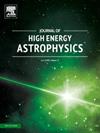具有更高非度规性和平方迹的观测约束加速宇宙学模型
IF 10.2
4区 物理与天体物理
Q1 ASTRONOMY & ASTROPHYSICS
引用次数: 1
摘要
本文提出了一个在f(Q,T)引力下的宇宙宇宙学模型,其参数受宇宙学数据集的约束。最初,f(Q,T)模型的广义形式被用作f(Q、T)=−λ1Qm−λ2T2,其中λ1、λ2和m是模型参数。通过一些代数运算,哈勃参数是根据红移得到的。然后,使用MCMC分析,使用最新的哈勃和万神殿+数据约束模型参数。模型参数也通过BAO数据集进行了验证。该模型显示了宇宙的早期减速转变为加速阶段。Om(z)诊断指示正斜率,有利于模型处于体模场主导阶段。本文章由计算机程序翻译,如有差异,请以英文原文为准。
Observationally constrained accelerating cosmological model with higher power of non-metricity and squared trace
In this paper, a cosmological model of the Universe is presented in gravity and the parameters are constrained by cosmological data sets. Initially, a generalised form of model is used as , where , and m are model parameters. With some algebraic manipulation, the Hubble parameter is obtained in terms of redshift. Then, using MCMC analysis, the model parameters are constrained using the most current Hubble and Pantheon+ data. The model parameters are also verified through the BAO data set. The model shows an early deceleration transitioning to an accelerating phase of the Universe. The diagnostic indicates a positive slope, favouring the model to be in a phantom field dominated phase.
求助全文
通过发布文献求助,成功后即可免费获取论文全文。
去求助
来源期刊

Journal of High Energy Astrophysics
Earth and Planetary Sciences-Space and Planetary Science
CiteScore
9.70
自引率
5.30%
发文量
38
审稿时长
65 days
期刊介绍:
The journal welcomes manuscripts on theoretical models, simulations, and observations of highly energetic astrophysical objects both in our Galaxy and beyond. Among those, black holes at all scales, neutron stars, pulsars and their nebula, binaries, novae and supernovae, their remnants, active galaxies, and clusters are just a few examples. The journal will consider research across the whole electromagnetic spectrum, as well as research using various messengers, such as gravitational waves or neutrinos. Effects of high-energy phenomena on cosmology and star-formation, results from dedicated surveys expanding the knowledge of extreme environments, and astrophysical implications of dark matter are also welcomed topics.
 求助内容:
求助内容: 应助结果提醒方式:
应助结果提醒方式:


